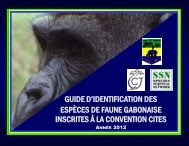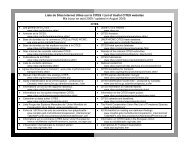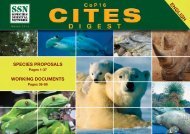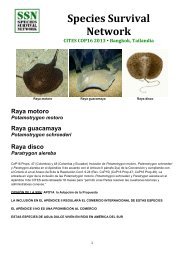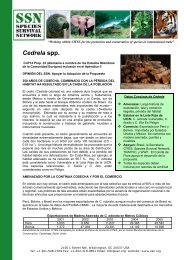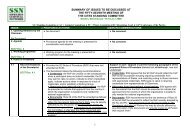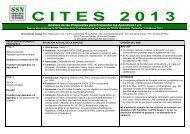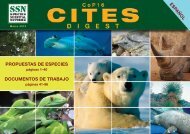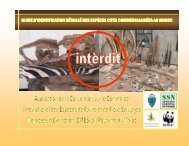SSN's Comments on South Africa's Regulations on Threatened and ...
SSN's Comments on South Africa's Regulations on Threatened and ...
SSN's Comments on South Africa's Regulations on Threatened and ...
You also want an ePaper? Increase the reach of your titles
YUMPU automatically turns print PDFs into web optimized ePapers that Google loves.
Clause 21(1)(d)(i) does not allow an animal to be hunted if it is -- “under the influence of tranquillizing<br />
or narcotic immobilizing or similar agent”. Animals should not be given any drug at any dose to ensure<br />
that they would be able to evade the hunter (“fair chance”). However, the draft clause implies that some<br />
level of drugging with some types of drugs would be acceptable. We recommend changing this clause<br />
to read, “… hunted if it has -- received any drugs, including but not limited to tranquilizers, narcotics or<br />
immobilizing agents.”<br />
Clause 21(1)(e) requires the permit holder to have all relevant documentati<strong>on</strong> authorizing the hunt “<strong>on</strong><br />
him or her” during the hunt. The term “<strong>on</strong> him or her” could be misc<strong>on</strong>strued (leaving it in a vehicle,<br />
for example). We recommend clarifying this clause to read “…authorizing the hunt <strong>on</strong> the body of the<br />
permit holder during the hunt”.<br />
Clause 21(1)(f)(ii) requires the permit holder to, within 21 days of the hunt, return informati<strong>on</strong> to the<br />
authorities, including the “species, gender <strong>and</strong> number of animals hunted”. We also recommend that<br />
the informati<strong>on</strong> include the estimated age of the animal <strong>and</strong> any evidence that, in the case of a female,<br />
she had young (i.e. lactating). This informati<strong>on</strong> is important to c<strong>on</strong>sider when determining the<br />
c<strong>on</strong>servati<strong>on</strong> impact of the hunt.<br />
Clause 21(2)(a) allows the use of dogs to track a wounded animal. This is subjective <strong>and</strong><br />
unenforceable. Further elaborati<strong>on</strong> is needed regarding evidence needed to dem<strong>on</strong>strate that dogs were<br />
used to track an animal <strong>and</strong> did not participate in the hunt.<br />
Clause 21(2)(d)(ii) prohibits hunting of animals in a “small enclosure where the animal does not have a<br />
fair chance of evading the hunter”. The term “small enclosure” is subjective, unenforceable, <strong>and</strong><br />
requires further elaborati<strong>on</strong>; this term would, at any rate, need to be defined <strong>on</strong> a species-specific basis<br />
(what is large for <strong>on</strong>e species may be small for another). Even fairly large enclosures have corners<br />
where animals can be baited <strong>and</strong>/or trapped. We recommend replacing the word “small” with “any”.<br />
The term “fair chance” is a key phrase that is highly subjective; either an objective, enforceable<br />
definiti<strong>on</strong> of “fair chance” is needed or the term should be eliminated from the draft text. We<br />
recommend replacing it with “…animal cannot evade the hunter.”<br />
Clause 21(4) allows the use of a motorized vehicle to track animals in areas where the hunt takes place<br />
over “l<strong>on</strong>g ranges” provided that the animal is not shot from the vehicle “except in the case of a<br />
wounded animal”. First, we do not underst<strong>and</strong> how hunting with vehicles can be c<strong>on</strong>sidered ethical<br />
c<strong>on</strong>duct or provides the animal with a “fair chance” of evading the hunter, particularly with larger<br />
animals. Sec<strong>on</strong>d, the term “l<strong>on</strong>g ranges” requires further elaborati<strong>on</strong> <strong>on</strong> a species-specific basis. Third,<br />
the fact that a wounded animal can be shot from a vehicle is an unenforceable loophole that would<br />
allow hunting from vehicles.<br />
Cancelled permits to be returned to issuing authority<br />
Clause 25(1) states that cancelled permits must be returned to the issuing authority within 30 days of<br />
the date of cancellati<strong>on</strong>. Paragraph (2) states any failure by a permit holder to return a cancelled permit<br />
in accordance with sub-regulati<strong>on</strong> (1) “may be taken into account by an issuing authority when<br />
c<strong>on</strong>sidering any future applicati<strong>on</strong> from that pers<strong>on</strong>…” We recommend, as an incentive, that if permits<br />
are not returned, future applicati<strong>on</strong>s by that permit holder should not be c<strong>on</strong>sidered. At the very least,<br />
we recommend that failure to return cancelled permits must (replace “may”) be c<strong>on</strong>sidered by the<br />
issuing authority when c<strong>on</strong>sidering future applicati<strong>on</strong>s.<br />
9



